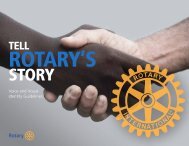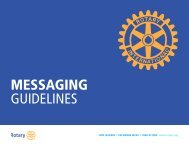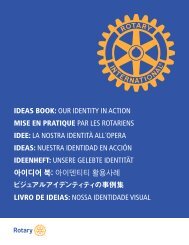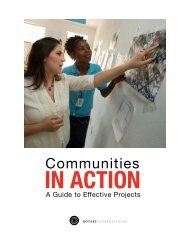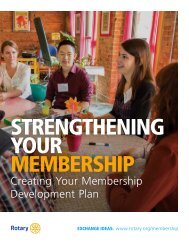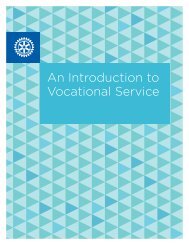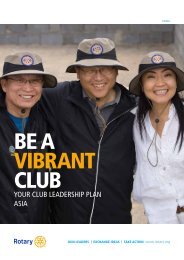Community Assessment Tools
Rotary International a companion piece to communities in action
Rotary International a companion piece to communities in action
Create successful ePaper yourself
Turn your PDF publications into a flip-book with our unique Google optimized e-Paper software.
6. <strong>Community</strong> Cafe<br />
A community cafe creates the atmosphere of a restaurant or<br />
cafe in which small groups of people from the community<br />
discuss issues raised by facilitators. It can be both an entertaining<br />
event for Rotarians and a unique way to learn about<br />
a community by engaging stakeholders in a direct dialogue.<br />
Each table has a “host,” or facilitator, who guides discussions on<br />
a particular topic. Participants move from table to table after a<br />
certain amount of time. As each issue is discussed, major ideas<br />
are recorded by the hosts, who report the most common ideas<br />
from their discussions to the cafe “maitre d’,” or head facilitator.<br />
Clubs can use these ideas to determine what projects to undertake<br />
in their communities.<br />
<strong>Community</strong> cafe session plan<br />
This session plan for conducting a community cafe can be<br />
adapted to fit your club’s specific needs.<br />
Objectives<br />
• Engage community stakeholders in meaningful<br />
discussions about their community.<br />
• Identify the major issues a community faces.<br />
• Establish relationships between your club and the<br />
community.<br />
Time<br />
1½-2 hours<br />
Preparation<br />
Although a community cafe can be run by a single facilitator,<br />
it is recommended that clubs choose one lead facilitator and<br />
a team of assistants to host each discussion table. Choose<br />
table hosts who are able to listen carefully and to guide,<br />
rather than dominate, discussions. Participants will move<br />
from one discussion table to another, so choose a location<br />
that’s both convenient for participants and large enough to<br />
enable people to move around easily.<br />
Meet with your team of table hosts to clarify the purpose of<br />
the community cafe. Consider these questions:<br />
• What issues do we want to discuss?<br />
• Who should be invited? You’ll need at least 20<br />
participants to yield productive discussions.<br />
• What questions should we ask to stimulate creative<br />
thinking and meaningful discussion?<br />
Decide each table’s discussion topic(s) and the table host’s role<br />
in the discussion.<br />
transport from one table to another. Create an environment<br />
in which participants will feel comfortable and free to discuss<br />
issues as though they were at a dinner with friends.<br />
Send invitations, clearly describing the purpose of the event.<br />
Materials<br />
• Invitations<br />
• Food, beverages, and utensils (if needed)<br />
• Enough tables and chairs to allow for a different<br />
discussion topic at each table<br />
• Pens or pencils for each table host<br />
• Notepads for each table host<br />
Procedures<br />
1. Before participants arrive, make sure your food, tables,<br />
and hosts are in place. (15-30 minutes)<br />
2. Greet participants as they arrive, encourage them to<br />
get food and drink, and seat them at discussion tables.<br />
(15-30 minutes)<br />
3. Once everyone has arrived, introduce yourself and<br />
explain the purpose of your assessment and the procedures<br />
for the discussions. (5-10 minutes)<br />
4. Have the table hosts start their discussions, taking<br />
notes and facilitating the discussion.<br />
5. Every 20 minutes, have participants switch tables to<br />
discuss a different issue or topic. Before the discussion<br />
begins, have each table host summarize the main<br />
points from the previous group’s discussion. Continue<br />
the process until everyone has discussed each topic.<br />
6. Ask each host to share with the entire group a summary<br />
of the major ideas discussed at his or her table.<br />
(15-20 minutes)<br />
7. Thank participants for attending. (5 minutes)<br />
8. Meet briefly with all the hosts to discuss what they<br />
learned and observed. Collect the notes from each<br />
table and summarize the major themes. (10-20<br />
minutes)<br />
9. Send your summary report to participants after the<br />
event.<br />
Variations<br />
• Keep tables together and have each table host discuss<br />
a different topic every 20 minutes.<br />
• Have one participant at each table serve as table<br />
host.<br />
Serving food is an important part of this activity. Usually,<br />
light snacks accompanied by coffee, tea, and soft drinks are<br />
best because they will not impede conversation and are easy to<br />
<strong>Community</strong> <strong>Assessment</strong> <strong>Tools</strong> 7





